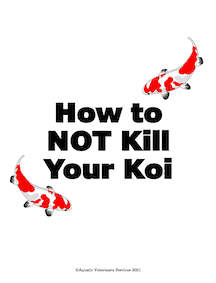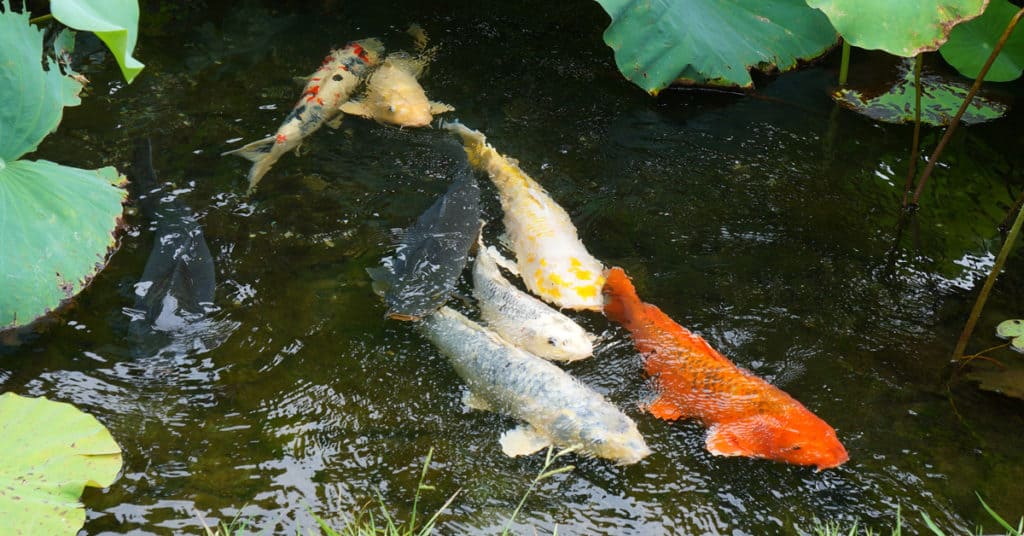Koi are the most common fish we see through our veterinary service. The majority of issues in koi are secondary to poor water quality. We understand that in drought prone areas, doing your regular water changes can be difficult. With limited maintenance, stress from poor water quality often leads to secondary diseases involving bacteria, parasites and fungi.
What are your water quality parameters?
If you are having an issue with your koi, check your water quality FIRST. If your parameters are not within range, it is time for a water change. Always use a liquid-based test kit that has been purchased within the last year. The expiration date is only for the store shelves.
| Parameter | Range |
| Ammonia | ≤ 0.1 mg/L |
| Nitrite | 0 mg/L |
| Nitrate | < 20 mg/L |
| pH | 6.5-8.5 |
| kH (alkalinity) | > 100 mg/L |
| gH (total hardness) | > 100 mg/L |
| Temperature | Seasonal |
If your parameters are within range, how many fish are affected? Is it just one fish or more than one? If only one fish is acting sick, move it to your quarantine system. If you do not have a quarantine system, you should get one set up or have one ready.
Does your koi have a lump, bump or change in color?
Koi are prone to many different skin issues. If you have a doitsu, or scaleless, koi, they are more prone to scale loss and losing one scale can look like a giant hole in the side of your fish. Bruised and retained scales may lose blood flow and turn green or brown from secondary algae growth. Koi can get sunburned and skin cancer, known as hikui. As they age, koi may change their color with normal aging, diet or water chemistry.
There are two common herpesviruses in koi. Cyprinid herpesvirus-1 is commonly known as carp pox. It causes irregular skin growths, but is not detrimental to your koi’s overall health. Cyprinid herpesvirus-3 is known as Koi Herpes Virus and is highly contagious and can kill koi. Screening is available for all new fish or fish of concern.
Does your koi look fat or asymmetrical?
One of the most common issues we see in koi are gonadal sarcomas. These are space-occupying tumors most common in female koi that cause a prolonged pregnancy appearance. It is important that these tumors are caught early. If you have a fish that looks “fat” or “pregnant” for a long period of time, or has an asymmetrical belly, they need to be screened ASAP. This is commonly misdiagnosed as a fish being “egg bound.” Screening is a painless process performed with ultrasound under anesthesia. Surgical treatment is available as long as the tumor is caught early.
Request An Appointment For Your Koi
See Our Pond Subscription Program
Our Most Popular Koi Articles
- Top 5 Spring Diseases in Koi
- Top 5 Most Common Problems with Koi Ponds
- The Realtor’s Guide to Selling a Home with a Koi Pond
- Male vs. Female Fish
- Barley Straw in Koi Ponds
- Plants in Koi Ponds
- Egg Binding in Koi
- How Long Do Koi Live?
- Koi Herpesvirus Testing
- Fake Fish Diagnoses
- Can Koi & Goldfish Be Kept Together?
- Disaster Planning for Fish
Download How to NOT Kill Your Koi
Koi ponds are much more involved than putting fish in a hole in the ground. Learn all about these majestic fish and their lifestyle requirements. Topics include how many fish to stock in your pond, dietary requirements and common diseases. Also includes a helpful pond maintenance checklist with all the daily, weekly, monthly, seasonally and yearly tasks to keep your fish happy and healthy.


Download & Subscribe
"*" indicates required fields

